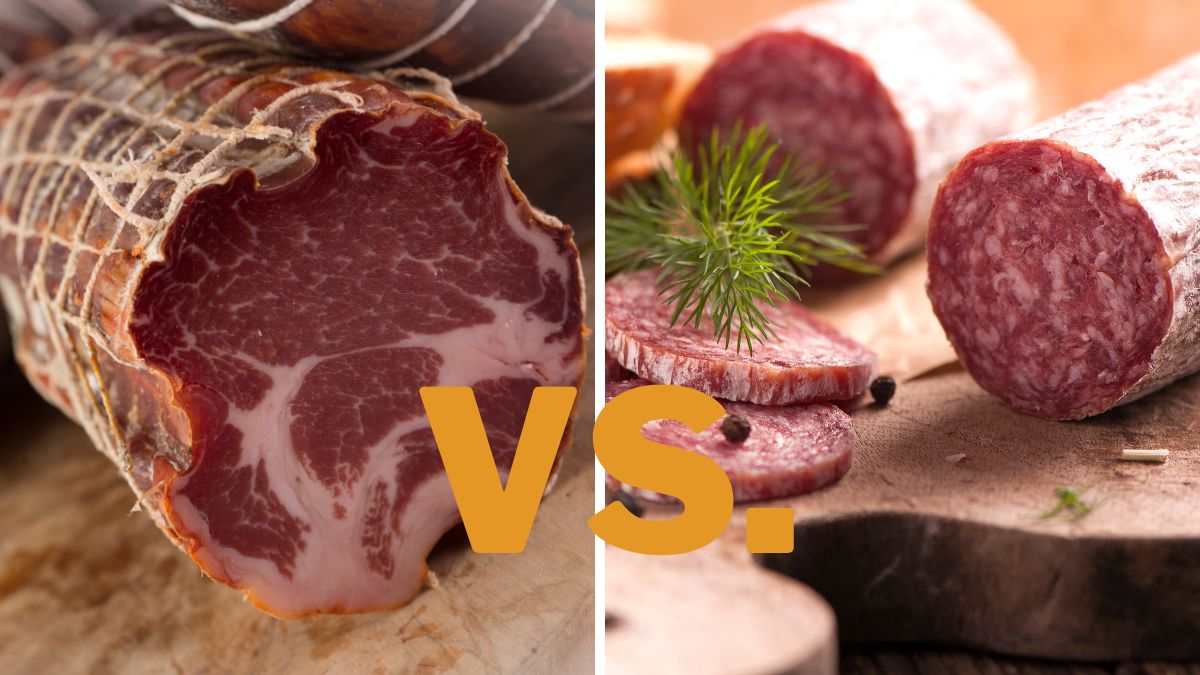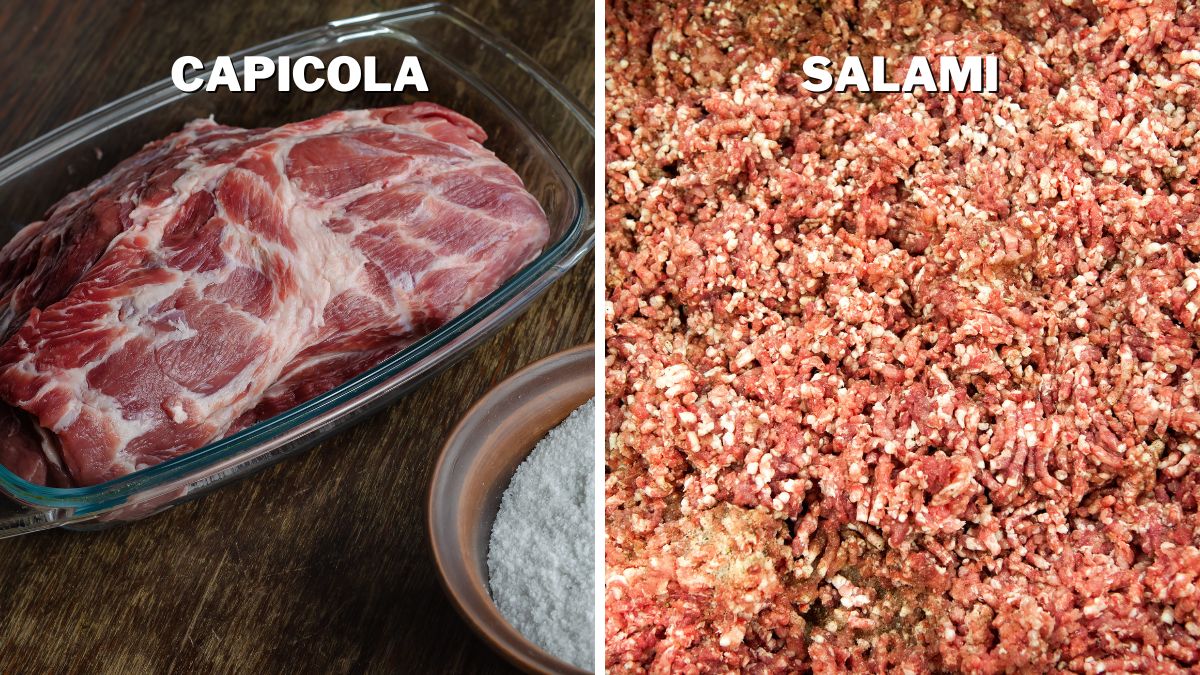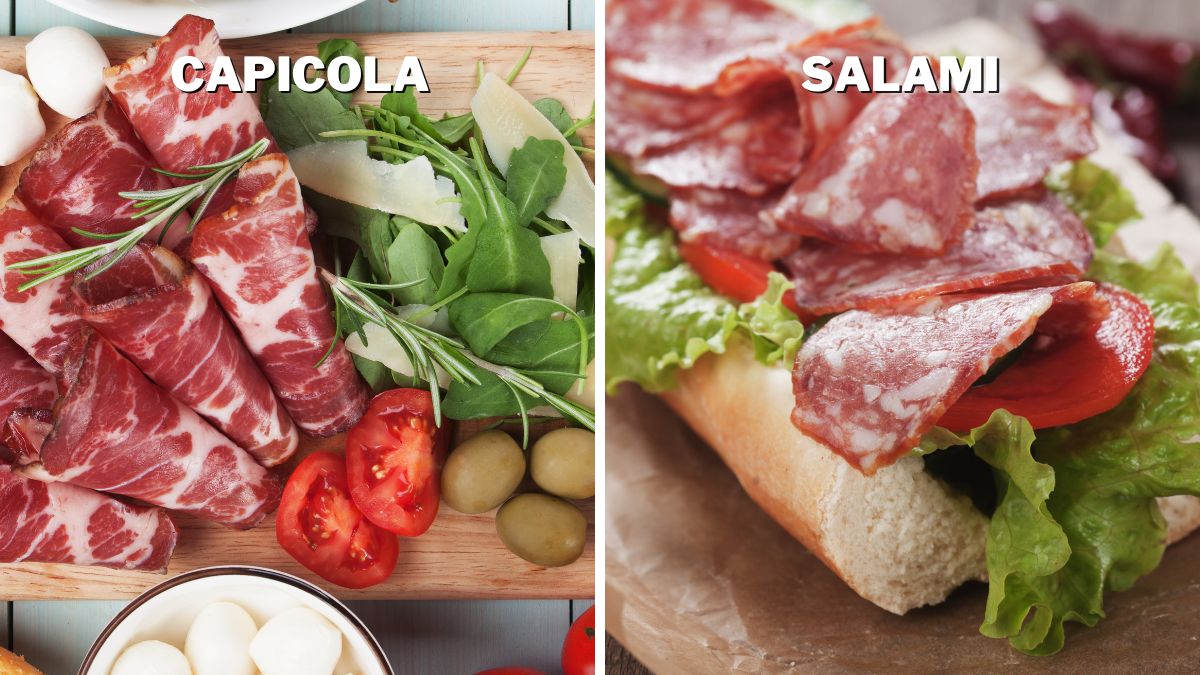Capicola vs. Salami: Differences & Which Is Better?

Capicola and salami are beloved deli meats you have probably already enjoyed. Before writing this, I knew they were different, but I wasn’t sure how. Even though knowing the differences between these two types of meat may not change your life, it will definitely change your meal experiences! So what are the differences between capicola and salami?
Capicola (also known as coppa) is a type of cured Italian meat made from pork shoulder or neck, while salami is a type of cured sausage-shaped meat made from pork or sometimes beef. Capicola is typically tenderer and has a richer flavor, while salami is firmer and has a more intense, spicy taste.
I’ve had many heated discussions about cured meats and their differences, and you would be amazed at how many people know very little about this subject. Many don’t find it essential, but the differences are what makes each of these meats a delicacy in its own right. So, to help you choose the best one for you and what you intend to make, I will give you some helpful information about the differences between capicola and salami.
Preparation and Ingredients

The preparation processes and ingredients are the roots of the differences between capicola and salami. They are both types of cured meats, and that’s the only point where they overlap.
Capicola is made from pork shoulder or neck. The first step in preparing it is the seasoning. The seasoning blend is often a secret of the maker, but it usually contains garlic, fennel, and black pepper, among other spices. After being seasoned, the meat is cured, which takes several months.
Just like capicola, salami is also made with pork, but it can sometimes be made with beef or another type of meat. Unlike capicola, which is cured as a whole piece, salami meat is ground and encased before aging.
The seasoning is also an important step of salami preparation, whereby the blend often includes garlic, red pepper flakes, and fennel. Just like with capicola, the seasoning blend of salami is often proprietary and a valued secret of the maker.
After being ground, seasoned, and encased, salami is left to age anywhere from a few weeks to several months, during which it becomes firmer and develops its taste.
I find both types of meat incredibly delicious, but I am a bit more inclined toward capicola because of its smoky note.
Taste
Both capicola and salami are very rich and satisfying meats, which is why they are so popular. Still, they are very different in terms of flavor, and there are people who prefer one over the other. Capicola has a rich and savory flavor hinting at garlic and fennel, while salami is slightly tangy, a bit sour, and noticeably spicier than capicola.
Capicola also has a tenderer texture and is generally juicier than salami. Salami, on the other hand, is drier and has a more robust texture than capicola. While you can slice capicola with smooth knife moves and very little effort, slicing salami could be a challenge, as it is significantly denser.
Uses
Capicola and salami have a very wide field of use. You can add both wherever you lack flavor, but also you can have them as a cold snack. Capicola is perfect for depth and flavor to sandwiches, cold platters, and pasta dishes.
Salami is also very versatile, and you can use it in many dishes. It is known for its flavor-enhancing properties, which is why it makes such a great addition to sandwiches, pizzas, and pasta dishes.
I personally favor salami for cooking and prefer capicola for sandwiches and other meals that don’t require cooking. Still, you can use both any way you like, as they do excellently when cooked as well.
Nutrition
Coming from the neck muscle, capicola is a high-protein food. It doesn’t contain carbs, but it is high in fat and calories. [1]
Salami is also protein-rich. However, since it is cured with salt, it is pretty high in sodium. It is also high in fat and calories. [2]
Nutrition is an aspect in which capicola is pretty similar, and they are both recommended to have in moderation. Generally, cured meats are not considered the healthiest meat option, so pace yourself with them. It’s a bummer, I know. [3]
Variations and Serving Styles

Capicola and salami are made worldwide, so their variations include different seasonings, different methods of making, or different sizes, but they are pretty standard and don’t vary much.
For example, salami can be made with bigger or smaller meat bits and can be made with pork, beef, or another meat, but the principle is the same, ground seasoned meat, stuffed in a casing, and then aged.
The same goes for capicola. It can be made with different spices, but at the end of the day, it is cured and juicy.
Except for being thinly sliced, capicola and salami hardly have a particular way of serving. Depending on the occasion and dish, they can be served on a fancy decorated plate combined with other fancy foods or slapped on a piece of bread topped with ketchup or mayo.
The bottom line is you can serve and have them according to your taste and mood; they work any way you like them.
Final Thoughts: Which Is Better, Capicola or Salami?
Capiola and salami are different, and you can’t compare them in a way to say that one is better. It depends on your preference and the particular meal. Some meals go better with one or the other, which, again, is up to you to decide.
You can experiment and see which works better for you. I prefer salami for pasta and pizza, and capicola for sandwiches or cold platers.
